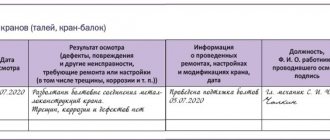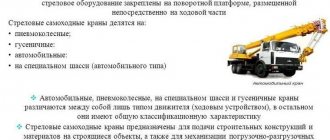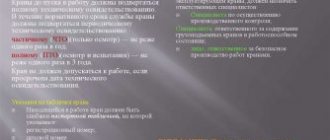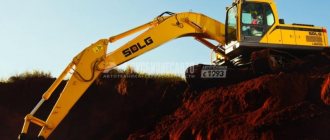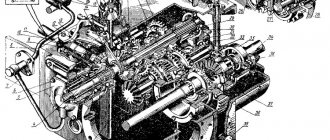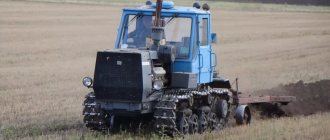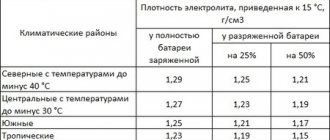Frequency of full (PTO) and partial (PTO) technical inspection of cranes
All load-lifting cranes and load-handling devices that are subject to industrial safety rules are subject to periodic inspection in accordance with the requirements of regulatory documentation of the Russian Federation. Technical inspection of lifting machines can be scheduled or unscheduled.
All lifting mechanisms must undergo routine technical inspection:
- Partial technical examination (PTO) – at least once a year
- Full technical examination (PTO) - at least 1 time every 3 years
Unscheduled technical inspection of lifting machines is carried out:
- Based on the results of installation of the crane, transfer to a new location.
- When carrying out reconstruction: replacement of movement units, lifting, re-equipment of the trolley for another load-handling mechanism (grab, magnet), reduction/increase in span, increase in load capacity.
- Repair of load-bearing metal structures of the crane
- Replacing the hook suspension
- Carrying out major repair work
Technical inspection of lifting mechanisms is a mandatory set of works during operation. Properly carried out inspection allows us to ensure further safe operation and trouble-free operation.
Technical examination of a lifting structure
This load is hung on the hook of the crane and all movements of the PS (crane) are performed in turn at least 3 times.
For a substation equipped with two or more lifting mechanisms, if their separate operation is provided, each mechanism must be tested for static and dynamic loads. The results of the technical examination of the lifting structure (crane) are recorded in its passport with the obligatory indication of the next date, WHAT and PTO.
Marking of a lifting structure (crane).
! Marking of a lifting structure (crane) is a plate on the PS (crane) or a stencil, which must be located in any place visible to the slinger, where there should be: 1) Serial (inventory) number of the lifting structure (crane). 2) Loading capacity from the passport.
3) Date of the next technical training. For example: No. 6 Q = 10 t PHE What is included in the weight of the lifting structure (crane).
Full and partial inspection of the crane
Any equipment, including load-lifting cranes, must have a personal instruction manual, based on which regular maintenance is carried out (Resolution of the Ministry of Emergency Situations of the Republic of Belarus dated May 15, 2015 No. 23). This condition is necessary so that during the inspection process it can be reliably determined whether the PMG is in working order, how reliable and safe it is for operation. Maintenance also includes an inspection of the load-lifting crane for its correct, accurate installation in compliance with all parameters.
There are several types of technical examination of equipment:
- complete (PTO),
- partial (WHAT).
As a standard, this is carried out once a year, however, after reconnecting or replacing the ropes, a partial inspection is carried out again in order to determine the reliability of the fastenings.
Technical maintenance is carried out once every three years, as well as at the initial stage before the introduction of lifting equipment into operation.
Important! If the crane is not used constantly, then it is classified as rarely used (in agreement with Gospromnadzor). Technical maintenance of such equipment should be carried out once every five years.
In the event of an unscheduled replacement of components, load-bearing elements, restoration, renovation and repair, the need for unscheduled maintenance may arise.
During a full technical inspection of cranes, static and dynamic tests are carried out - this is its main difference from a partial inspection.
What is included in the static testing of lifting equipment?
The PMG is installed in such a way that the bridge is bent as much as possible. In this position, the crane must lift a special load (25% heavier than normal) and hold it for 10 minutes. After the procedure, specialists check the bridge and, if defects are found, the crane will not be allowed to operate until the causes of the deformation are identified.
What is included in the dynamic testing of lifting equipment?
Dynamic means movement. Therefore, the basic requirements for installing the crane remain the same (the load is 10% heavier than normal), but the lifting and lowering of the load is done 3-4 times. The purpose of this test is to check the serviceability of the lifting mechanism and its brakes.
Important! All necessary components (test weights, etc.) for performing test work are provided by the owner of the lifting equipment.
The specialist performing the control records the results of maintenance and the date of the next inspection in the technical passport of the crane. The entry made must confirm that the gas turbine unit meets all operating requirements, has passed the tests and is in good condition.
Did you find apk for android? You can find new Free Android Games and apps.
Files for download:
| Rules for ensuring the safety of cranes (.pdf) | Download | 281.13 KB |
Industrial safety examination
An industrial safety examination is mandatory for carrying out a set of works during the operation of a hazardous production facility. When conducting an examination, it is necessary to be guided by Federal Law No. 116 “On Industrial Safety of Hazardous Production Facilities.”
Technical examination of lifting structures
For all lifting structures specified in clause 3 of the FNP PS (both those registered with Rostechnadzor and those not subject to registration with Rostechnadzor) it is necessary to carry out a technical examination.
a load-lifting cranes of all types;
b overhead stacker cranes;
in pipe-laying cranes;
g cranes;
d construction lifts;
e lifts (towers) designed to move people, people and cargo (lifts with working platforms);
g electric freight trolleys moving along elevated rail tracks together with a control cabin;
h electric hoists;
and excavator cranes designed to work with a hook;
to replaceable load-handling devices and removable load-handling devices (hooks, grabs, magnets, spreaders, traverses, grippers, slings), used in conjunction with the PS for lifting and moving loads;
l containers for transporting goods, with the exception of special containers used in metallurgical production (ladles, molds), as well as special containers used in sea and river ports;
m special removable cabins and cradles, hung on the load-handling parts of cranes and used for lifting and moving people;
n rail tracks (for supporting and suspended substations moving on rails).
Scope of work, procedure and frequency of technical examination:
Lifting structures must undergo technical inspection before they are put into operation, as well as during operation. The scope of work, the procedure and frequency of technical examinations are determined by the manual (instructions) for the operation of the substation. A similar amount of work is performed during extraordinary technical examinations in cases established by the Federal Tax Service.
The static test is carried out by loading the lifting structure at 25% greater than the rated load capacity.
Dynamic testing of a lifting structure is carried out with a load 10% greater than the rated load capacity.
The purpose of the static test is to check the strength of metal structures and mechanisms of the substation. During dynamic testing, the operation of mechanisms and brakes is checked.
PRELIMINARY ONLINE APPLICATION
Testing of lifting mechanisms, technical devices for lifting loads, lifting structures, structures, cranes, hoists.
Lifting structure - definition of the term. A lifting structure is a single system that combines building structures and structures, with designated boundaries determined by production processes and characteristics that include a lifting machine or mechanism.
The main control measures carried out during the operation of the lifting structure are determined by the requirements of the Federal norms and regulations in the field of industrial safety “Safety rules for hazardous production facilities where lifting structures are used”, introduced by Order of Rostechnadzor dated November 12, 2013 N 533 (FNP PS) . These include:
- technical examination (TO);
- industrial safety examination (ISA).
TYPICAL TECHNICAL SPECIFICATIONS FOR TECHNICAL INSPECTION OF LIFTING STRUCTURES AND MECHANISMS Khimnefteapparatura LLC carries out technical inspection of lifting structures in the shortest possible time at an objective price based on the technical specifications. received from the customer. You can download a technical specification document template and send it to our email address to clarify the details, timing and cost of work with our specialists.
File name: Terms of reference for inspection of lifting structures
121082 287228.13KB
Technical examination of lifting structures
For which lifting structures is technical inspection carried out?
For all lifting structures specified in clause 3 of the FNP PS (both those registered with Rostechnadzor and those not subject to registration with Rostechnadzor) it is necessary to carry out a technical examination.
a load-lifting cranes of all types;
b overhead stacker cranes;
in pipe-laying cranes;
g cranes;
d construction lifts;
e lifts (towers) designed to move people, people and cargo (lifts with working platforms);
g electric freight trolleys moving along elevated rail tracks together with a control cabin;
h electric hoists;
and excavator cranes designed to work with a hook;
to replaceable load-handling devices and removable load-handling devices (hooks, grabs, magnets, spreaders, traverses, grippers, slings), used in conjunction with the PS for lifting and moving loads;
l containers for transporting goods, with the exception of special containers used in metallurgical production (ladles, molds), as well as special containers used in sea and river ports;
m special removable cabins and cradles, hung on the load-handling parts of cranes and used for lifting and moving people;
n rail tracks (for supporting and suspended substations moving on rails).
Scope of work, procedure and frequency of technical examination:
Lifting structures must undergo technical inspection before they are put into operation, as well as during operation. The scope of work, the procedure and frequency of technical examinations are determined by the manual (instructions) for the operation of the substation. A similar amount of work is performed during extraordinary technical examinations in cases established by the Federal Tax Service.
FREQUENCY OF TECHNICAL INSPECTION DURING THE SERVICE LIFE OF THE LIFTING STRUCTURE:
- partial technical examination (PTO) - at least once every 12 months;
- full technical examination (PTO) - at least once every 3 years, with the exception of rarely used substations .
SCOPE OF WORK DURING TECHNICAL INSPECTION OF LIFTING DEVICES, MECHANISMS, CRANES AND STRUCTURES:
- partial technical examination (PTO) – inspection only;
- full technical examination (PTO) – inspection, static tests of lifting mechanisms, dynamic tests of lifting mechanisms.
The static test is carried out by loading the lifting structure at 25% greater than the rated load capacity.
Dynamic testing of a lifting structure is carried out with a load 10% greater than the rated load capacity.
The purpose of the static test is to check the strength of metal structures and mechanisms of the substation. During dynamic testing, the operation of mechanisms and brakes is checked.
Who carries out the technical inspection?
A specialist responsible for carrying out production control during the operation of the substation, as well as with the participation of a specialist responsible for maintaining the substation in working condition. At the same time, technical inspection of lifting structures is permitted to be carried out by expert organizations.
The technical inspection of lifting structures is carried out by experts from Khimnefteapparatura LLC, certified in the manner established by the Decree of the Government of the Russian Federation of May 28, 2015. No. 509 “On the certification of experts in the field of industrial safety.”
What is done during a technical inspection?
During a technical inspection, the lifting structure must be inspected and its mechanisms, brakes, hydraulic and electrical equipment, indicators, limiters and recorders checked.
During the technical inspection of the crane, the condition of the metal structures of the crane and its welded (riveted, bolted) connections must be checked (no cracks, deformations, loosening of riveted and bolted connections), as well as the condition of the cabin, stairs, platforms and fences, the condition of the hook and blocks.
During the technical inspection of lifts the following must be checked:
- the condition of the metal structures of the lift and its welded (bolted) connections (no cracks, deformations, loosening of bolted connections), as well as the condition of the cabin, stairs, platforms and fences;
- compliance with the drawing and lift passport data with the actual installed weight of the counterweight and ballast (if any);
- condition of fastening of axles and pins; condition of hydraulic equipment (if any);
- electrical grounding condition; operability of catchers with testing (for construction hoists);
- checking the accuracy of stopping the car with full working load and without load (for construction hoists).
How to make a duplicate passport for a lifting structure?
According to clause 144 of the FNP PS, a duplicate of the passport and a duplicate of the operating manual (instructions) must be produced by the manufacturer of the lifting structure. Or by a specialized organization licensed to conduct an industrial safety examination, while the expert organization prepares a duplicate passport based on the industrial safety examination carried out before the start of operation of the substation at the hazardous production facility.
If during operation the passport and/or operating manual for the lifting structure are lost, then to restore them it is necessary to carry out technical diagnostics.
At the end of the service life of lifting structures subject to registration in Rostekhnadzor, it is necessary to conduct an industrial safety examination to assess the terms and conditions for further safe operation of the substation.
At the end of the service life of lifting structures that are not subject to registration by Rostechnadzor, it is necessary to carry out technical diagnostics.
Inspection of cranes | Web Mechanic
Hello, dear friends. I am glad to see you again on the Web-Mechanik.RF portal. Today we will look at the inspection of cranes, the purpose and procedure for conducting a technical inspection of cranes, as well as the scope of work during a full technical inspection.
Technical examination of cranes
Technical inspection of cranes can be partial or complete.
During the standard service life, periodic technical inspection of cranes is carried out in the following periods:
a) partial - at least once every 12 months;
b) complete - at least once every 3 years, with the exception of rarely used cranes (cranes for servicing machine rooms, electrical and pumping stations, compressor units, as well as other cranes used only for equipment repairs).
A full technical inspection of cranes that are classified as rarely used is carried out at least once every 5 years. The classification of cranes into the category of rarely used is carried out by the owner in agreement with the Rostekhnadzor authorities.
Technical inspection of cranes aims to establish that:
a) the crane and its installation comply with PB Rules No. 533, passport data and submitted documentation;
b) the crane is in a condition that ensures its safe operation.
Full technical examination of cranes
During a full technical inspection, the crane must undergo:
a) inspection;
b) static tests;
c) dynamic tests.
Partial technical examination of cranes
A partial technical examination of cranes differs from a complete one in that static and dynamic tests of the crane are not carried out.
Scope of work during technical inspection of cranes
When carrying out a technical inspection of cranes, it is necessary to inspect and check the operation of its mechanisms, brakes, hydraulic and electrical equipment, instruments and safety devices. Checking the serviceability of the load limiter of a jib-type crane should be carried out taking into account its load characteristics.
In addition, during the technical inspection of the crane the following must be checked:
a) the condition of the metal structures of the crane and its welded (riveted) connections (no cracks, deformations, thinning of walls due to corrosion, weakening of riveted connections, etc.), as well as the cabin, stairs, platforms and fences;
b) the condition of the hook and blocks. For cranes transporting molten metal and liquid slag, for ladle lifting and tilting mechanisms, inspection of forged and stamped hooks and parts of their suspension, as well as suspension parts of plate hooks, must be carried out by the factory laboratory according to instructions using non-destructive testing methods at least once every 12 months . The laboratory report must be stored together with the crane passport.
c) the actual distance between the hook suspension and the stop when the limit switch is activated and the lifting mechanism stops (must be at least 200 mm for cranes);
d) the state of insulation of wires and grounding of the electric tap with determination of their resistance;
e) compliance of the mass of the counterweight and ballast of the jib crane with the values specified in the passport;
f) the condition of the rail track, its compliance with the substation operating manual, the project, as well as the requirements of these FNP;
g) the condition of the ropes and their fastenings;
h) state of lighting and alarm.
Static tests of the crane are carried out with a load 25% greater than its rated load capacity.
Static tests of an overhead crane are carried out as follows. The crane is installed above the supports of the crane track, and its trolley (trolleys) is installed in a position corresponding to the greatest deflection of the bridge. The test load is lifted by crane to a height of 100 - 200 mm and maintained in this position for 10 minutes.
Crane testing
When conducting a full technical inspection, the crane must be subjected to:
- inspection;
- static tests;
- dynamic tests.
Consultation and placing an order for testing lifting equipment .
Let's consider testing using the example of overhead cranes.
To conduct static and dynamic tests, the crane owner must ensure the availability of a set of test (control) weights indicating their actual weight in the “Control weight certificate”.
Test loads are prepared that are 10% and 25% greater than the crane's lifting capacity. Both indivisible and assembled cargo from several parts are suitable. The weight of the cargo is checked using verified scales and verified with the data specified in the “Control Cargo Passport”. Testing of magnetic and grab cranes can be carried out with a magnet or grab attached respectively. For hook cranes, slings are prepared corresponding to the weight of the load being lifted.
Static tests of the crane are carried out with a load 25% higher than the load capacity specified in the crane passport (certificate load capacity) and are aimed at checking the crane structure for readiness to withstand the declared loads.
The procedure for conducting static tests of an overhead crane:
- The crane is installed above the supports (columns) of the crane track, and its trolley (trolleys) is installed in a position corresponding to the greatest deflection of the bridge (at the center of the span)*.
- Basic inspection and measurements of the crane structure are carried out.
- The test load is lifted by crane to a height of 100 - 200 mm and maintained in this position for 10 minutes.
- After 10 minutes, the load is lowered and the crane structure is again inspected and measured to ensure there is no permanent deformation.
*Static testing of gantry crane and overhead material handler is carried out in the same way as overhead crane testing; in this case, for a crane with consoles, each console is tested separately.
The crane is considered to have passed the static tests if, after 10 minutes, no cracks, residual deformations or other damage to the metal structures and mechanisms of the crane are detected.
If cracks, residual deformations and other damage resulting from static tests of the crane with a load are detected, the crane should not be allowed to operate. The possibility of further operation of the crane is determined by a specialized organization after the causes of deformation are clarified.
Dynamic tests of the crane are carried out with a load 10% greater than the lifting capacity specified in the passport (certificate lifting capacity) and are aimed at checking the actions (operability) of mechanisms and brakes.
During dynamic tests of cranes, the load is lifted and lowered multiple times (at least three times), as well as the operation (at least three times) of all other mechanisms is checked when combining the working movements provided for in the crane operating manual.
For a crane equipped with two or more lifting mechanisms, each mechanism must be tested separately. And then when combining the working movements of the mechanisms provided for in the crane operating manual.
The crane is considered to have passed the dynamic tests if, after their completion, no cracks, residual deformations or other damage to the metal structures and mechanisms of the crane are detected.
If cracks, residual deformations and other damage resulting from dynamic tests of the crane with a load are detected, the crane should not be allowed to operate. The possibility of further operation of the crane is determined by a specialized organization after the causes of deformation are clarified.
Load-lifting cranes that do not pass the test are considered to have not passed technical examination and are not allowed to work.
Note:
- If the crane is used only for lifting and lowering loads (for example, lifting valves in a hydroelectric power plant), dynamic tests can be carried out without moving the crane itself or its trolley.
- Tests of a crane that has several replaceable load-handling elements must be carried out with the load-handling element that is installed at the time of testing.
- Static tests of overhead cranes intended for servicing hydro and thermal power plants can be carried out using special devices that make it possible to create a test load without the use of a load. Dynamic tests are not carried out in this case. To test cranes using special devices, the crane owner or a specialized organization must develop additional instructions.
The test results, as well as the technical examination of the crane, are recorded in its passport by the person who carried out the examination, indicating the date of the next examination.
Permission for further operation of the crane is issued by the person who conducted the inspection.
Survey and examination
Scope of work during a partial technical examination (WHAT):
Conducting a partial inspection of cranes includes a comprehensive check of the condition of the equipment and equipment of the machine, technical documentation and inspection of metal structures:
During the process the following are checked:
- Electrical equipment and condition of cable products
- Brake systems
- Safety devices
- Condition of metal structures
- Compliance of crane tracks with safety rules, availability of grounding of crane tracks
- Rope-block system, condition of ropes, attachment points
- Availability of technical documentation (crane passport, crane track, comprehensive inspection, maintenance)
- Organization of a safe operation service for the facility, availability of responsible specialists
An organization that uses lifting structures in its activities is obliged to conduct a partial technical examination at least once every 12 months.
A full technical inspection (FTE) includes all the work included in the WHAT, plus:
- Static tests (carried out with a load exceeding the crane’s lifting capacity by 25%)
- Dynamic tests (carried out with a load exceeding the crane’s lifting capacity by 10%)
A set of documentation based on the results of the technical examination:
Based on the results of technical inspection work, the following documentation is provided:
- Static test results report
- Report on the results of dynamic tests
- Certificate of full technical examination (PTO) or partial technical examination (PTO) or List of defects identified during the examination
Comprehensive examination
A comprehensive inspection of the track is mandatory in accordance with the requirements of industrial safety rules; work on a comprehensive inspection is carried out by specialized expert organizations that have the appropriate license to perform work of this type.
The frequency of a comprehensive examination is at least once every 3 years. In the intervals between inspection work, at least once a year, the owner of the lifting structure must ensure that the crane tracks are leveled to control the horizontal position and ensure safe operating conditions.
In the absence of proper fastening of the guides, or the presence of deviations exceeding permissible standards, there is a possibility of an emergency situation, a threat to the life and health of operating personnel.
In the event of an emergency equipment failure, unexpected equipment downtime occurs, which inevitably entails economic losses in production.
During the comprehensive survey work, they are checked.
- Availability of an organized service for operating the lifting structure
- Technical and operational documentation
- Planned-altitude survey and inspection of crane track elements is carried out
- Guides (rail, square, I-beam)
- Butt and intermediate fastenings
- Dead-end stops, limiters, guards, warning signs, grounding
- Metal structures and their fastening units
